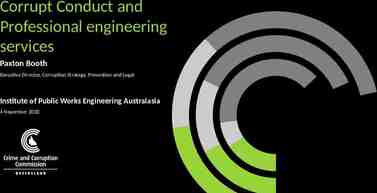Chapter 9 Auditing Revenue and Related Accounts
20 Slides154.00 KB
Chapter 9 Auditing Revenue and Related Accounts
Introduction Financial transactions processing cycles Revenue Acquisition/payment Payroll Financing Cash and short-term investments
Overview of Revenue Cycle Internal Control Objectives The Revenue Accounting System Receive a customer purchase order Check inventory stock status Generate back order Obtain credit approval Prepare shipping and packing documents Ship and verify shipment of goods Prepare the invoice. Send monthly statements to customers Receive payments
Assessment of Environment Risk Audit steps: update info on business risk understanding of internal controls document accounting applications preliminary assessment of environment risk if control risk at maximum; determine types of likely misstatements develop procedures to lower control risk perform audit tests, and modify control risk if justified.
Inherent Risk Improper Revenue Recognition Schemes Recognition of revenue on shipments that never occurred. Hidden “side letters” allowing returns. Consignment sales shown as final sales. Shipment of unfinished products. Shipment of product before customers agreed to delivery.
Inherent Risks: Sales Transactions Difficult Audit Issues When to recognize revenue. Impact of unusual terms of sale. All goods sold were shipped. Handling of recourse sales.
The Control Environment: Effect on Sales Focus On: Integrity of management Financial condition of the organization Financial pressures facing the organization Management incentives to achieve various financial goals
The Control Environment: Effect on Sales Sources of useful information in evaluating control environment: Financial press articles Trade journal articles Industry growth statistics Preliminary analytical procedures
Understanding Internal Controls Walk-through of the processing. Inquiry. Observation. Review of the client’s system documentation. MUST DOCUMENT IN WORKING PAPERS.
Developing an Understanding Existence/Occurrence Completeness Rights/Obligations Valuation Presentation and Disclosure Maintaining Accounting Integrity
Evaluating Control Risk Monitoring Controls. Control Structure Regarding Returns, Allowances, and Warranties. Importance of Credit Policies Authorizing Sales.
Assessing & Documenting Environment Risk Testing for the Operating Effectiveness of Control Procedures. Reassessment of Control Risk. Linking Environment Risk Assessment and Substantive Testing.
Substantive Testing in the Revenue Cycle Planning for Direct Tests of Account Balances. Account balance relationships. Risk of material misstatement. Makeup of the account balance. Persuasiveness of procedures. Cost of the procedures. Timing of procedures. Determining optimal mix of audit procedures.
Audit Objectives and Assertions Existence and Occurrence. Completeness. Valuation. Rights and Obligations. Presentation and Disclosure.
Standard Accounts Receivable Audit Procedures Aging accounts receivable. Confirming receivables with customers. Related-party receivables Cutoff tests Non-current receivables Adjusting audit program to the environment. Confirmation of sales.
Confirmations When required. Types of confirmations. As audit evidence. Accuracy and security of process. Sample selection. Sampling unit. Undeliverable confirmations.
Confirmations (cont.) Follow-up to non-responses: Positive confirmations Alternative Procedures: Subsequent collection. Supporting documentation. Follow-up to non-responses. Follow-up procedures: exceptions noted. Interim date confirmations.
Confirmations (cont.) Summarizing Confirmation Work Related Party Receivables. Cutoff Tests. Noncurrent Receivables. Sold, Discounted, and Pledged Receivables. Adjusted Audit Program to the Environment.
Allowance for Doubtful Accounts Review and test the process. Develop an independent model. Review subsequent events or transactions. Write-offs.
Analytical Procedures Ratio Analysis Trend Analysis Reasonableness Tests Notes Receivable

























